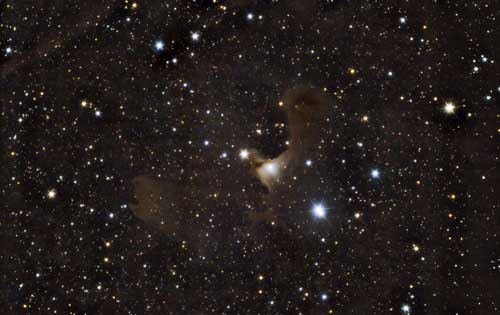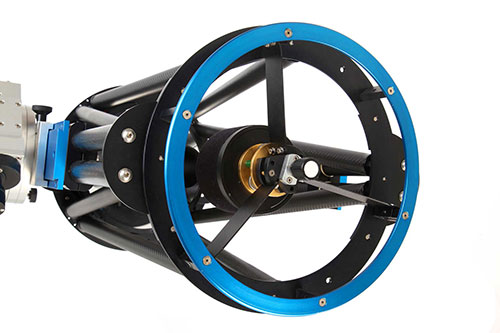RC 250
The NortheK RC 250 is the advanced solution for wide-field astronomical photography.
The high-correction Ritchey Chrétien design allows oustanding wide field photography, flat field until the edge, and fully illuminated on the sensor up to a 30 mm diameter, for your enjoyment whit the CCDs and most of DSLRs.
Small and easy-to-manage, lightweight, mechanically highly sophisticated, this instrument is ideal for the astronomer on-the-move.
The highest advanced technology applied on an amateur instrument, and the attention to detail in research and development made by Maxproject Team, result in a durable quality telescope and a secure return of your investment.
Description
The NortheK RC 250 is a Cassegrain telescope based on the Ritchey Chrétien system where both the primary and the secondary mirrors have hyperbolic surfaces. The instrument is designed to provide a wide field of view for photographic use while still fixing to a small sized mount. The wide field also makes the design very suitable for direct viewing.
Every detal has been thoroughly considered in the RC 250 project.
All the metallic parts are precision engineered in steel or aluminium alloys (anticorodal and ergal). The surfaces are protected with either chromium-plating or a high quality anodised coating to ensure a long life.
The design aim was to produce a very resistant structure as the extreme sensitivity of modern sensors doesn’t allow uncontrolled movements due to expansion, deflection or bending. This is achieved by using separate end rings that are connected by no less than eight truss tubes laid in a triangular position. In this way Optical Tube Assembly (O.T.A.) will not suffer any mechanical or thermal stress that would in turn disturb the light path through the telescope and cause distortion or defocusing of the image, so the best optical and mechanical performance is guaranteed.
The structure has also been fitted with a very thin carbon tube with the sole purpose of protecting the optical set up from unwanted light or dirt.
Three rear extracting fans take your telescope to the thermal equilibrium quickly. Moreover the low-expansion glass used in the primary mirror allows a rapid change to ambient temperature within 20 minutes, followed by stable conditions for the rest of the observation session.
Please observe in detail all the solutions adopted in the NortheK RC 250.
The primary mirror cell with 18 contact points, the aluminium baffle, the primary perimeter shield, the mechanical adjustments for the collimation of the optics made of steel in techno polymer supports and designed to work in any thermal and environment conditions. The precision of the adjustments is such that the setting accuracy is less than a hundredth of a millimetre and is extremely stable. This allows quick and easy setting of the telescope collimation.

ic414-1 Giampaolo Salvato & Elio Magnabosco – RC 250 f 8,5 + reducer AP 0,67 – ccd QHY8 PRO
No extruded parts are used in the NortheK RC 250, all components are machined from solid in specific alloys. The secondary mirror is provided with easy but accurate axial adjustments while the radial movement of the secondary (which is critical in the Ritchey Chrétien design) is normally set in the factory but it can be adjusted locally with a sophisticated tensile system studied to keep the tension between the supports whilst allowing their decentralization. The entire central block is held by two tanden supports spaced out by steel bars to avoid any twisting movement on the secondary axis.
A sophisticated FTF 2000 Feather Touch focuser is provided. This allows the observer to set and maintain the focus easily and accurately.
This motor driven focuser is compatible with most PC based programs for telescope management that use ASCOM protocol. An additional feature provided is a temperature sensor positioned near the primary mirror that can be made available to the telescope management software.
Finally, any variation on the light cone is avoided by the use of the carbon fibre which allows the accurate control of any thermal expansion along the tube axis and radii. The use of carbon fibre has been specifically studied at the simulator the Maxproject Team who holds the patent of the design of the NortheK RC 250 tubes. Moreover, the tubes surfaces have been ground and protected from UV and climate conditions by a special coating.
The OTA tube design haas been over-specified so that it can accept any accessories without flexions that would affect the performance.
The optics are made with low expansion glass and have a surface accuracy better than 1/10 lambda (PtoV) by Oldham Optical in Scarborough (U.K). The certificate supplied with the instrument guarantees you have purchased the ultimate quality for this price range.
Take a look at the single detail; ask for further explanations, we would be glad to show you the high precision and sophistication of this Ritchey Chrétien project!

The exact optical parameters such as back focus, distance between primary and secondary, dimensions of the glasses, are confirmed exactly in the optical certificate provided with each optic and/or instrument.
|
|||||||||||||||||||||||||||||||||||||||||||||||||||||||||||||||||||||||||||||||||||||||||||
NortheK RC 250 – the matter of the totally corrected field.
This interesting photographic instrument has got accurate technical specifications and, above all, a fully illuminated flat field with a 30 mm. diameter.
In order to fully cover a DSLR sensor it is necessary 44 mm. diameter totally illuminated flat field, but most of the amateur CCDs are completely covered (please refer to Technical Topics section “Notes fot Astronomical photography“).
Having said that, the amateur astronomer could think that the instrument performance is not quite good enough for DSLR astronomical photography.
That’s not the case and we are going to explain to you why and, if you want some further explanations about the equations and spread sheets, do not hesitate contact us.
In our design the Airy disc is: 2.349 timex (x) wave lengh x focal ratio (where the wave lenght = 546 nm).
With a simple equation we can work out the dimensions of the disc which will blur because of the field curvature (the light in the centre is perfectly focused but anything out the dimensions of axis is degrading more and more because of the field curvature).
Whit this equation we get a mid figure that we will name “x”. We can then work out this figure with another simple equation.
Once these figures have been calculated, it will be possible to see how, for a 30 mm. diameter, the blurring due to the curved field is about half the Airy disc. This figure is actually too low have an effect on any photographic shot possible with this diameter and it is instead absolutely perfect for the amateur CCD.
The only way for this telescope to have a blur bigger than the Airy disc, would be with a field wider than 40 mm.!
NortheK RC 250 gives you various options:
a) Work with high definition using the best performance but limit the field to 30 mm.: best for CCD and still very good for DSLR;
b) Use a 40 mm. field with a slight (only slight) degradation on the edge;
c) Move the focus between the centre and the edge of the field. Calculations confirm that this will reduce the blurring on the edge to ¼ but it will increase of ¼ in the centre. The area in between is perfectly focused.
As you can see, whatever your needs or the objects to be viewed, you can have high performance instrument at a limited cost.
Obviously there are also other ways to avoid the field curvature:
a) To use a field flattener;
b) To reduce the distance between the primary and the secondary.
The reason why Maxproject Team has not considered any of therm is because they are either not necessary or too expansive for the diameter of the instrument.
| deformate superficie specchio Ritchey Chrétien 254 mm. f 8,5 |
 |
 |
 |
 |
 |
 |

